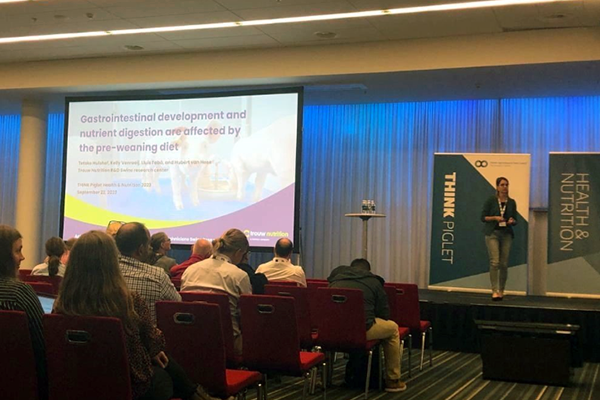Optimizing nutrition strategies: a report from the PIG Research Summit
- Swine
On 21 and 22 September, the PIG Research Summit took place in Copenhagen, organized by Seges from Denmark. The summit offered insights into crucial topics on feeding strategies for sows and piglets. We summarize the key findings for you.

Part 1: Pre-farrowing Feeding Strategies
During the first part of the PIG Research Summit, important insights were shared regarding the feeding of sows before farrowing.
It was shown that supplemental lysine (range 3.4-6.2 SID Lysine per kg feed) during gestation led to additional maternal growth, especially in second- and third-parity sows. Arginine supplementation between days 14 and 28 of gestation reduced variation in birth weights. An interesting new study in Denmark focuses on the effects of feeding frequency during the gestation period (1-2 times compared to 3 times daily).
In addition, research showed that increased feed intake in the last 28 days of the gestation period had little effect on birth weights. Feeding sows several times a day can shorten farrowing time. However, in a recent Dutch study with a specific transition feed fed at a level of 3.6 kg per day (in practice often less than 3 kg per day), this effect was not seen.
Inert fibre around farrowing reduced diarrhea in piglets during lactation. Replacing vitamin D3 with 25-hydroxycholecalciferol significantly increased sow vitamin D status.
Part 2: Feeding for High Milk Production
During the second part, the importance of proper udder tissue development for optimal milk production was highlighted. The role of lysine in the last 20 days of gestation was also highlighted. Using a transition mixture (50% gestation feed and 50% lactation feed) for 5-7 days before parturition to 3-5 days after parturition reduced weight and lard thickness loss during lactation compared to an abrupt switch from gestation to lactation feed.
Nitrogen retention trials during 3 lactation weeks showed that the optimal SID lysine/Mcal ratio increases during lactation. A trial of oregano addition during gestation and lactation resulted in increased presence of immunoglobulins in both colostrum and milk.
Part 3: Pig Immunity
In the third part, experiments related to piglet immunity were shared. Different strains of probiotics were inoculated in piglets in the farrowing pen, resulting in measurable shifts in gut bacteria and gene expression. Less diarrhea was observed in the inoculated group compared to the control group.
A Danish study focused on the development of immunity in relation to colostrum supply, finding that later-born piglets are more likely to suffer from asphyxia symptoms (elevated blood lactate levels). These less vital piglets go to the udder later and take in less colostrum with already lower levels of immunoglobulins.
Part 4: Design of the Farrowing Pen
The fourth section, "Design of the Farrowing Pen", focused on the future of the farrowing pen. Besides movement possibilities, proper arrangement of specific functional areas is very important. Enrichment of farrowing pens, for example with jute bags, was viewed positively. A study on the effect of farrowing pens where the sow's lying area rises when standing showed no significant difference in mortality until day 4 after farrowing.
During a presentation by Trouw Nutrition, it became clear that in a specially developed "family stall pen", the percentage of piglets taking feed before weaning was significantly higher (11%) compared to a standard farrowing pen. In the family frame pen, the sow and piglets share a common feeding area where they receive the same feed. However, providing (partial) lacto feed after weaning resulted in an increased risk of diarrhea in piglets during the first 9 days after weaning. Therefore, an important practical conclusion is that it is crucial that piglets are fed suitable piglet feed in the last week before weaning and during the first week after weaning. It was also noticeable that piglets born in family pens had significantly less damage to their ears and tails both at weaning and five weeks after (20% on average).
Part 5: Management of Large Litters
Research among 30 pig farms in Denmark, which have an average of 19.1 live-born piglets per litter, showed that over 60% always or partially use split suckling to successfully rear more piglets. In addition, almost half of the farms apply energy supplements to newborn piglets.
A study on reducing umbilical hernia showed that male piglets with above-average growth were less likely to have this complication. Moreover, there was no significant difference between cutting a wet or dry umbilical cord, regardless of whether it was disinfected afterwards.
The last presentation in this section presented an experiment that followed the development of 107 litters until weaning. Each litter, consisting of 14 piglets, was raised by a sow with 14 functioning teats. The weight of the piglets at the time of castration (between 1 and 2.8 kg per piglet) on day 3-4, was found to be the most decisive factor in whether or not the piglets dropped out or were moved due to insufficient development. In the end, an average of 12.5 piglets per litter were weaned.
Part 6: Feeding of Piglets Before Weaning
The first presentation of the final section dealt with nutritional solutions following the ban on high zinc doses after weaning. Researchers stressed the need for targeted pre-weaning care to ensure piglet quality.
Giving milk before weaning resulted in 20% more eating piglets compared to a prestarter without dairy components. Milk products and oat hulls both promoted piglet gut development.
Trouw Nutrition’s research on pelleted and extruded feed before weaning showed that extruded feed encouraged more piglets to eat. Although digestion was faster, this type of feed also caused more diarrhea.